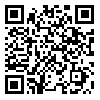BibTeX | RIS | EndNote | Medlars | ProCite | Reference Manager | RefWorks
Send citation to:
URL: http://mjiri.iums.ac.ir/article-1-2448-en.html
Background :SCORE, OST and ORAI risk assessment tools could reduce the cost burden of BMD tests by selecting the high risk patients to osteoporosis. In this study we compared the ability of these risk assessment measures to assess probability of the osteoporosis among post-menopausal women.
Methods : 211 post-menopausal women aged 45-88 years enrolled into the study. All of the patients underwent BMD test and divided into two groups according to T-Score level. 43 patients (20.4%) had T-Score ≤-2.5 (osteoporotic) (group-1) and 168 (70.6%) patients had T-Score of > -2.5 (non-osteoporotic). Among 168 non-osteoporotic cases, 88 had -2.5≤T-Score≤-2 in at least one bony area. These 88 cases in addition to the 43 cases with -2.5≤T-Score considered as high risk group to osteoporosis (group 2). Afterward, SCORE, OST and ORAI risk scores were calculated and sensitivity, specificity, likelihood ratio, accuracy index and area under the curve of each tool were determined in both groups and then compared with each other.
Results : SCORE had the highest sensitivity compared with others in both groups (95% and 88.2% respectively). Moreover, it had the highest diagnostic odds ratio and negative predictive value between the three methods. OST had the highest likelihood ratio and specificity in both groups (71.4% and 75.4%). There was significant difference between the sensitivity and specificity of the tests (p= 0.004 and 0.027).
Conclusion : OST with the highest specificity and positive LR had a special role in determining the osteoporotic patients and SCORE with the highest sensitivity and negative predictive value had an exceptional role in exclusion of the non- osteoporotic individuals. However, considering the area under the curve, there was no significant difference among these three methods in determining osteoporosis.
| Rights and permissions | |
 |
This work is licensed under a Creative Commons Attribution-NonCommercial 4.0 International License. |





